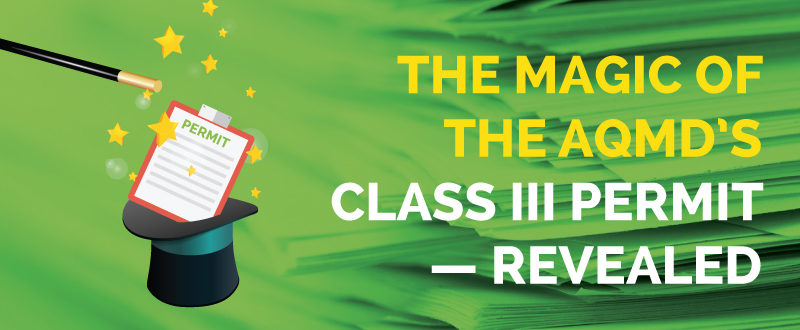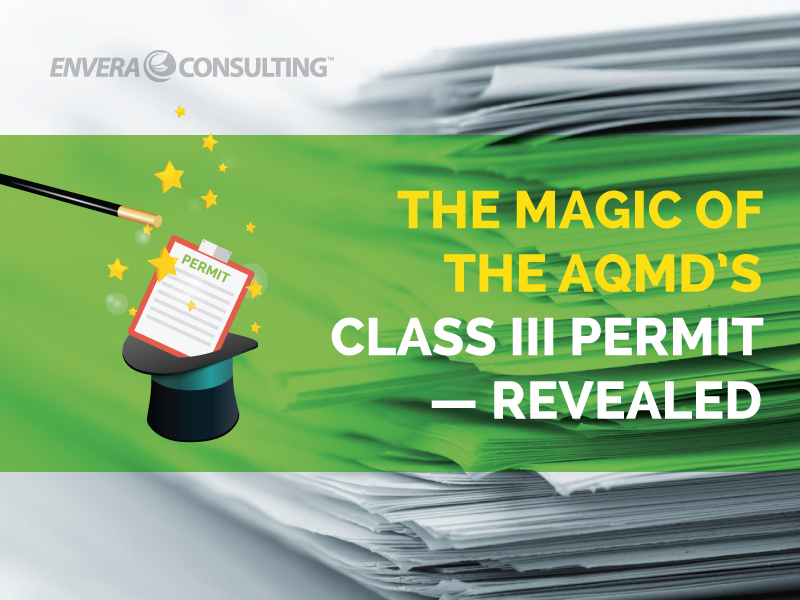

I’m about to share one of the most well-kept secrets about SCAQMD permitting there is to know. I’m doing so with the intent of showing you that the world won’t end if you happen to find yourself with un-permitted equipment. There are options.
Introducing the “Class III” permit
An air permit is a legal document that authorizes the holder to construct or operate a piece of equipment. The entire SCAQMD permitting process often takes 3-6 months — sometimes more.
But a Class III permit provides immediate permit coverage as soon as you file the application, along with applicable processing fees, with the SCAQMD. With so many SCAQMD processes requiring lengthy waiting times, this might seem unbelievable — like magic, in fact. But it’s actually a valid, although oft-overlooked, part of SCAQMD rules and regulations.
Rule 202 Authorizes the Class III permit
Although Rule 202 is a mere 251 words long, they are a magical 251 words. The rule provides the applicant a temporary permit to operate (the Class III) for a piece of equipment that was modified or existing without a previous permit. But there’s one big caveat: Your permit coverage can be canceled at any time at the discretion of the AQMD.
In the SCAQMD, Rule 201 requires all equipment to have a permit before it is constructed or modified. However, the agency understands that there will be cases where an applicant doesn’t properly follow this process — usually due to oversights or simple human error (as opposed to devious or dishonest behavior).
In this case, if a piece of equipment was installed without first getting a permit, then the equipment is arguably in non-compliance with Rules 201 and 203 and would continue to be in non-compliance until the permit is actually issued.
Rule 202 was created to limit the time frame that a piece of equipment operates in non-compliance. Those simple 251 words functionally say that once a permit application is filed and the proper fees are paid, the application itself serves as a permit to operate the equipment under Rule 202 and, arguably, the period of non-compliance with Rule 203 ends. Presto!
However, because the applicant did not initially follow Rule 201, a non-compliance risk for Rule 201 still exists, meaning the SCAQMD can issue a violation for Rule 201. In most cases, however, we’ve seen that the risk is quite low.
When Should You File for a Class III Permit?
Although there are other valid cases where a Class III permit can be used, the most common — and acceptable — is when you find un-permitted equipment during a facility audit and want to apply for a permit for good measure.
You should not file for a Class III permit as a means to circumvent the permitting process. This means that a Class III permit should not be used because you need a permit now and can’t wait for the SCAQMD to process the equipment.
There are cases when a Class III permit is valid — and cases where it’s not. It’s up to you to use discretion as to which case yours falls under.
How to Properly File a Class III Permit
Here’s the lowdown, in two simple bullets:
- Do tell the SCAQMD that you intend to file a Class III permit application for your facility.
- Don’t file a Class III that doesn’t contain permit conditions. The SCAQMD doesn’t like that, and it can send the wrong message about your operation.
The SCAQMD is playing nice by allowing the magical Class III permit to even exist, so you want to play nice in return. And if you don’t play nice, the SCAQMD can always reject your permit application under Rules 210 and 212, which would cause you to lose your coverage. That would put you right back at square one — do not pass Go, do not collect $200. (You may, in fact, end up paying far more than that.)
If filing the Class III permit is absolutely necessary, then file the permit with conditions and be clear to the SCAQMD about your circumstances. In almost all cases, the agency will work with you.
If, due to time constraints, you don’t yet have all the information the permit requires, let the engineer know when you hope to have it — and hold yourself to that deadline.
You can continue to operate with a Class III permit until the SCAQMD takes action, which would be to either grant or deny the official permit. In either case, if your equipment had or currently has a permit, then it must continue to be operated in compliance with the conditions noted on the original permit.
What Is Needed to File a Class III Permit Application?
Just like a regular SCAQMD air permit, a proper Class III permit application consists of forms, fees, and a detailed engineering evaluation. But there are four key differences to keep in mind:
- In your engineering evaluation, make it clear in the opening paragraph that you are filing for a permit for equipment that was either constructed or modified without a permit to construct. You can use the following wording:
This permit application is being submitted for equipment that was constructed/modified without first obtaining a permit to construct. - In the rule analysis section, be sure to include an analysis for Rule 202 and a statement indicating that the permit is being filed as a temporary permit to operate. Here’s some wording you can use:
This permit application is subject to Rule 202 since it is being filed for equipment that was constructed without first obtaining a permit to construct. It is understood this application serves as a temporary permit to operate. - In your fee calculation, be sure that you include the higher fee associated with the Class III permit.In Rule 301 (c)(1)(D)(i), the fee for filing a Class III permit is 150 percent of the base permit-processing fee. So if the base fee for your equipment is $3,927.10, then the total processing fee would be $5,890.65 (i.e., 3,927.10 x 1.5). Rule 301 does not currently apply this additional fee to small businesses (as defined in Rule 102) that have no previous history with the SCAQMD (i.e., those that do not have a facility identification number).
- In sections 7a and 7c of Form 400-A, be sure to check one of the following boxes:
- Equipment Operating Without A Permit
- Alteration/Modification without Prior Approval
What Happens After Filing a Class III Permit Application?
Once you file, you’ll receive notification from the SCAQMD that your application was received, at which point it will be processed just like a regular ol’ air permit would. That means that a permit engineer will rely on the information to determine whether the equipment can operate in compliance with all of the applicable rules. If the permit engineer requests further information, be sure to respond as quickly as possible to minimize any delays.
Because your application technically gives you a permit to operate, the SCAQMD gives these applications lower priority over other types of permit applications, such as permits to construct. So be prepared to wait.
Tada! There you have the basics of the Class III permit.
If you still need help demystifying the process, contact us and we’ll guide you through the process, presto chango.